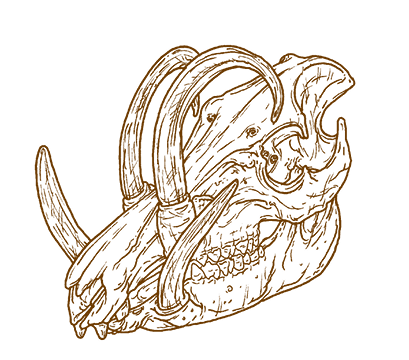
North Sulawesi Babirusa
Babyrousa celebensis
(bab-uh-roo-sa sel-eb-en-sis)

Visible only on male babirusas, the long, curly tusks of this giant mammal are its most peculiar feature. Females have them, too—but theirs are a lot smaller and stay hidden in their mouths. The tusks are actually the male’s upper canine teeth!
Males probably grow their tusks for display rather than combat. They’re too thin and brittle to withstand much force. When male babirusas fight, they don’t clash tusks—instead, they stand on their hind legs and box each other.
Their tusks grow throughout their lives and can reach 17 inches (43 cm) long. Sometimes the tusks will even grow through a babirusa’s skull if they aren’t worn down or broken off in a battle.
The babirusa has hairless, wrinkly skin. It’s also exceptionally large, weighing around 130 to 220 pounds (60–100 kg) when fully grown.

Where They Live
Like their name suggests, these babirusas live primarily in Sulawesi, Indonesia. In the past, they enjoyed living in low-lying areas around riverbanks and rain forests, where they could find many different kinds of food. But thanks to heavy hunting and habitat destruction, they’ve moved to higher ground, which is safer because it’s harder to get to.
What They Eat
Babirusas have such fierce-looking tusks, you’d expect them to hunt and eat large, intimidating beasts. But this isn’t the case at all! They forage through sand and mud for leaves, fruits, roots, insects, fish, and small animals, and use their powerful jaws to crack nuts.
Conservation Status
Vulnerable
Unfortunately, Sulawesi babirusas are among the first species to disappear from the ecosystem because of logging and deforestation. As their habitat is destroyed, their large size makes them easy to spot, and people love to hunt them for their meat and tusks. Their numbers have dropped by 30 percent in the past 20 years, and another 10 percent of them are expected to die out the near future.

Fun Facts
